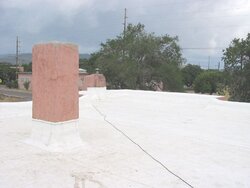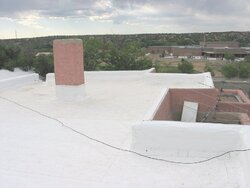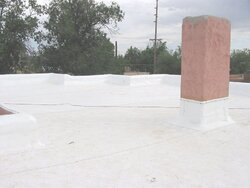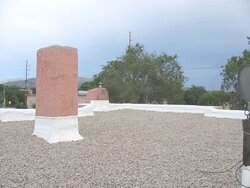I wasn't sure whether to put this in the Green Room or DIY, but I didn't DIM and it's the future of roofing (IMO) so here it is for the greenies.
After the mammoth snow we got last Xmas, my prior roof repairs got totally swamped causing significant damage to the plaster inside. Not good. It was time for the whole thing to be redone. This is a 77 year old house with the original coal tar roof and one reroof on top, and a foot of dirt on top of that. (Yes, one foot of dirt! The roof planks sit on 2"x12" joists on 18" centers.) Two roofs isn't bad for 77 years.
Because of the dirt, a more substantial repair with modern materials was ruled out - nothing I could put down myself would like being covered in dirt as time passed. So I decided not to do it myself, called out for bids, and got 5 companies to look it over and bid. Most of the local roofing "companies" all have the same last name (Lopez) and, it turns out, all process their proposals from one office onto different stationary, tweaking the final amount by a hundred or two to make them all look legitimately different...what a racket! Anyway, the bids ranged from $18,200 to $8,500, including the dirt removal. The four most expensive bids were for torchdown mod bit, the cheapest one was for TPO. I thought it curious that torchdown was more than double the cost. How could these good ole boys charge so much for old asphalt "technology" ? Well, it turns out, the answer is, because they can get away with it - by scaring people away from the "uncertainty" of using new materials (which really are better.) That was the essence of their pitch against TPO; it's "too new." The giveaway was that the bid amounts were inversely proportional to the intelligence level of the bidders.
After MUCH study and consideration (and many questions to the TPO guy) I went with him. His crew was great and did a very good job. You can see the attached pics. It's like having a shrinkwrapped roof. All that remains to be done is to put down the layer of ballast rock. I'll post a pic of that when they finish it.
Among the many "green" benefits of TPO is the approx. 92% reflectivity. When the sun is shining, it hurts my eyes to stand up there! Afternoon temps inside the house have dropped 2 degrees just from this one change. I love it.
Will post more impressions as they arise.
After the mammoth snow we got last Xmas, my prior roof repairs got totally swamped causing significant damage to the plaster inside. Not good. It was time for the whole thing to be redone. This is a 77 year old house with the original coal tar roof and one reroof on top, and a foot of dirt on top of that. (Yes, one foot of dirt! The roof planks sit on 2"x12" joists on 18" centers.) Two roofs isn't bad for 77 years.
Because of the dirt, a more substantial repair with modern materials was ruled out - nothing I could put down myself would like being covered in dirt as time passed. So I decided not to do it myself, called out for bids, and got 5 companies to look it over and bid. Most of the local roofing "companies" all have the same last name (Lopez) and, it turns out, all process their proposals from one office onto different stationary, tweaking the final amount by a hundred or two to make them all look legitimately different...what a racket! Anyway, the bids ranged from $18,200 to $8,500, including the dirt removal. The four most expensive bids were for torchdown mod bit, the cheapest one was for TPO. I thought it curious that torchdown was more than double the cost. How could these good ole boys charge so much for old asphalt "technology" ? Well, it turns out, the answer is, because they can get away with it - by scaring people away from the "uncertainty" of using new materials (which really are better.) That was the essence of their pitch against TPO; it's "too new." The giveaway was that the bid amounts were inversely proportional to the intelligence level of the bidders.
After MUCH study and consideration (and many questions to the TPO guy) I went with him. His crew was great and did a very good job. You can see the attached pics. It's like having a shrinkwrapped roof. All that remains to be done is to put down the layer of ballast rock. I'll post a pic of that when they finish it.
Among the many "green" benefits of TPO is the approx. 92% reflectivity. When the sun is shining, it hurts my eyes to stand up there! Afternoon temps inside the house have dropped 2 degrees just from this one change. I love it.
Will post more impressions as they arise.






 !! All are 20 or more years old technology. Hypolan is actually less popular in these parts due to the problems with it. And also since white EPDM or rubber has been around for years now.
!! All are 20 or more years old technology. Hypolan is actually less popular in these parts due to the problems with it. And also since white EPDM or rubber has been around for years now.
 That creates the pitch needed.
That creates the pitch needed.